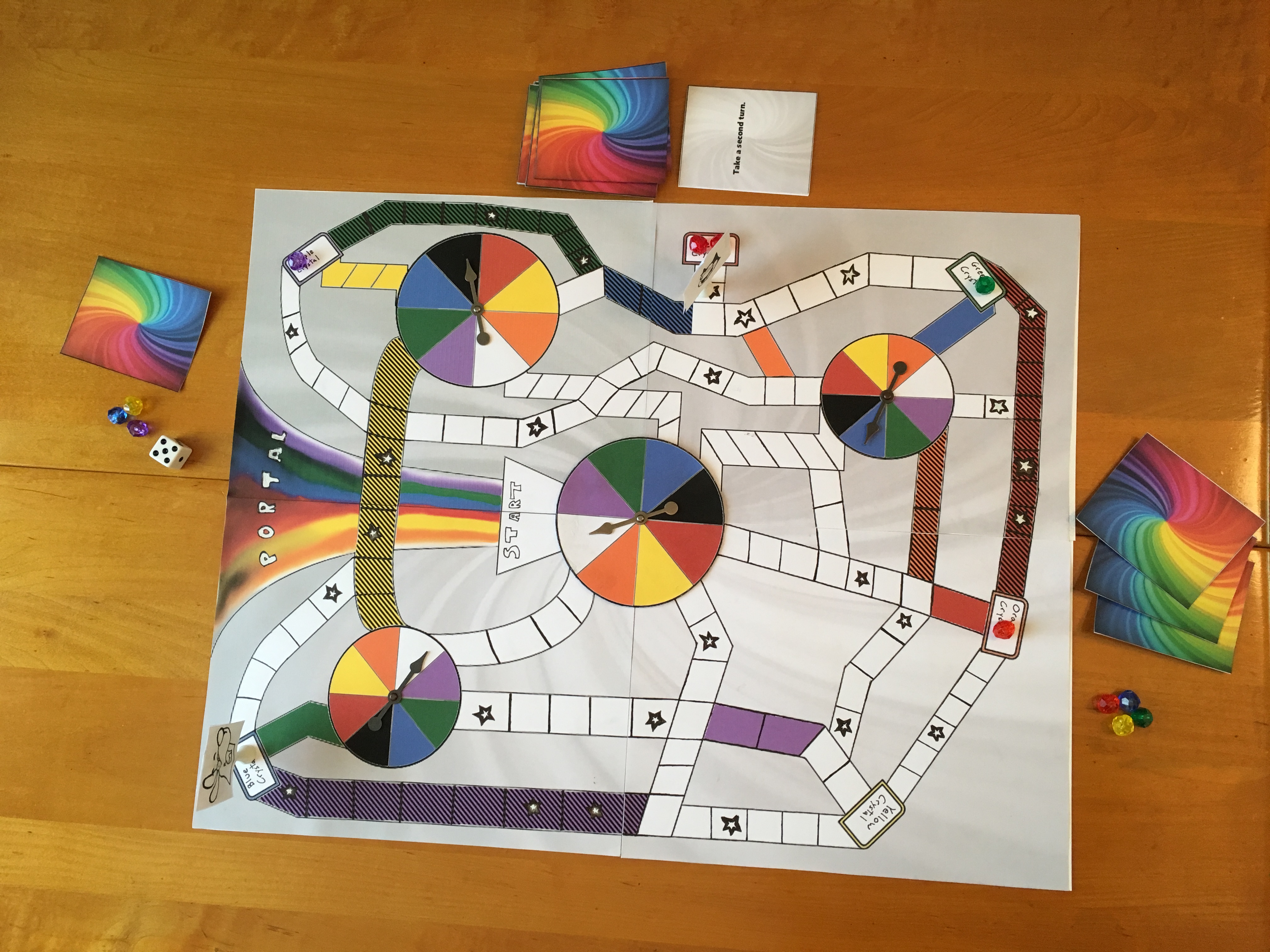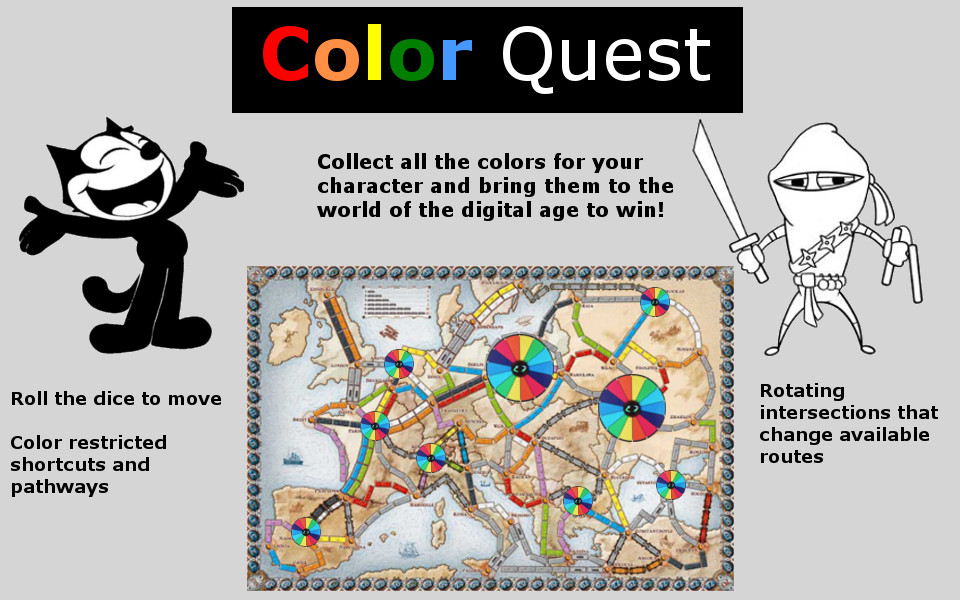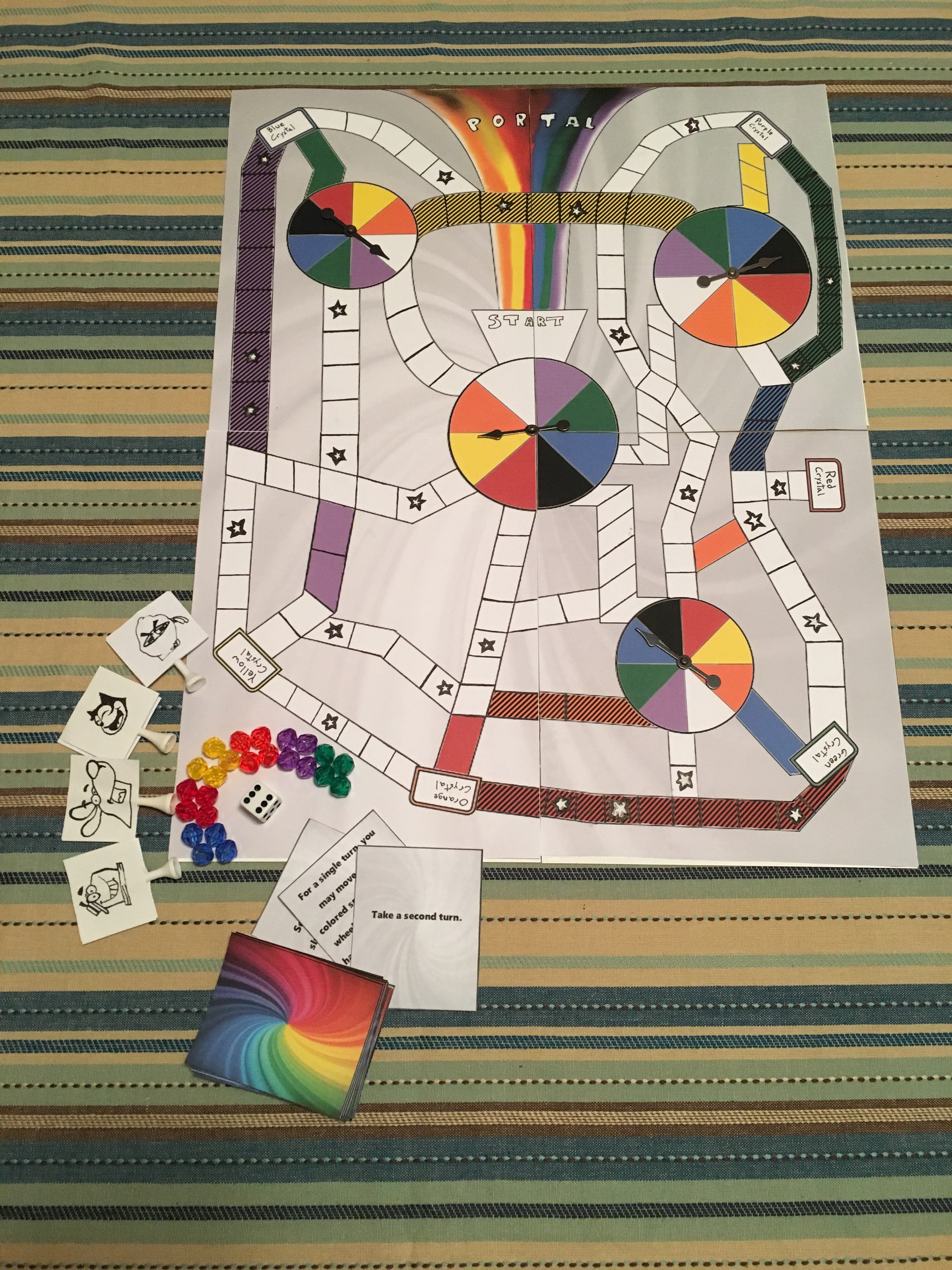Color Quest
Game Design 1 Final Project
Walkthrough Video
Rulebook
View the rulebook here.Project Premise
The premise of this project was to create a tabletop game, making adjustments based upon playtesting feedback.

Initial Pitch

Analysis: Balancing and Statistics
In the first iteration of Color Quest, the distribution of colored paths and color restricted paths heavily favored certain routes and encouraged moving in a single direction around the perimeter of the game board to collect the color crystals. To balance the paths better, I added additional routes to each color crystal space as well as altered the number, length, and placement of colored and color restricted paths. All colored paths are now extremely short and emphasized as shortcuts whereas color restricted paths are placed to divert players from the perimeter of the board. Ultimately, I was able to create a board that discouraged simply traveling in a circle and encouraged players to try different paths. While the board is not entirely symmetrical, the different routes are all comparable and viable, in part due to ability cards.
Initially, ability cards felt underwhelming. While the actual abilities of the cards proved to work well, the low frequency of ability card spaces made players mostly ignore them. Only about 8% of spaces on the first game board were ability card spaces, and its layout of colored paths made cards that could traverse paths or temporarily supply a color largely unnecessary. Additionally, the more powerful abilities of swapping an opponent’s color crystal or returning a player to Start only had a 3/27 and 2/27 chance of being drawn respectively, providing little incentive for players to stop on ability card spaces. By increasing the amount of ability card spaces on the board to around 19% in addition to changing the layout of the paths, ability cards became a more integral part of the game. With the higher rate of ability card acquisition, the ratio of powerful abilities to the rest of the deck is in a balanced state with each player having a decent chance of drawing one during the course of the game. Players now can decide between relying on ability cards to bypass heavily color restricted routes and going for the path with the least obstacles. Most of the actual abilities of the cards stayed the same from their initial versions, but one card had to be changed due to faulty wording. While it was only meant to allow players to travel across colored paths, the card’s wording was “pretend to have a color crystal you have not yet acquired.” Essentially, this let players win by only collecting five of the six color crystals with the use of this card. Therefore, to be able to balance around players collecting all six crystals, the wording used to communicate the card’s ability was completely changed. The card now says that players “may move across colored spaces (or color wheel) of a crystal you have not yet acquired,” which fixes the exploit.
First Playtest Game Board

First Playtest Feedback Form
Playtest Feedback
Game: Isaac Madsen
Date: 2/15/17
|
Player #1 Name: |
Samantha Silvers |
|
Feedback: (List Problems) |
|
|
Solutions: (Proposed Changes to Game) |
|
Miscellaneous Notes (Optional):
Overall, playtesting went very well.
Second Playtest Game Board

Second Playtest Feedback Form
Playtest Feedback
Game: Isaac Madsen
Date: 3/17/17
|
Player #1 Name: |
Jeanette (Mom) |
|
Feedback: (List Problems) |
|
|
Solutions: (Proposed Changes to Game) |
|
|
Player #2 Name: |
Daniel (Dad) |
|
Feedback: (List Problems) |
|
|
Solutions: (Proposed Changes to Game) |
|
|
Player #3 Name: |
Caleb (Brother) |
|
Feedback: (List Problems) |
|
|
Solutions: (Proposed Changes to Game) |
|
Miscellaneous Notes (Optional):
Having played my game before, both my mother and brother said the slight modifications to and increased frequency of the ability cards felt much better. They said the ability cards felt fun to use and they were much more motivated to acquire them.
The new pathing worked very well! Everyone started a different path yet still had a chance to win and no one simply circled around the perimeter.
Third Playtest Game Board

Third Playtest Feedback Form
Playtest Feedback
Game: Color Quest
Date: 4/16/17
|
Player #1 Name: |
Caleb |
|
Feedback: (List Problems) |
|
|
Solutions: (Proposed Changes to Game) |
|
|
Player #2 Name: |
Jill |
|
Feedback: (List Problems) |
|
|
Solutions: (Proposed Changes to Game) |
|
|
Player #3 Name: |
Paul |
|
Feedback: (List Problems) |
|
|
Solutions: (Proposed Changes to Game) |
|
Miscellaneous Notes (Optional):
I playtested my game with my cousins this week in order to get some fresh feedback. Surprisingly, their feedback was all extremely positive and there wasn’t really any “problem” I could translate from it.
My cousin Jill did suggest the possibility of adding more powerful ability cards, but it didn’t seem to be from the cards lacking any interest. She simply wanted to be able to take someone down! In fact, both of my cousins really enjoyed the ability cards and the game became very competitive with the use of the cards.
With the four of us playing, the game was very close. Potentially, I think the game may be more balanced for three or four people playing than only two, due to the higher volume of ability cards being played and the capability of the players to capitalize on the other players’ actions. The game certainly is more fun with four people. (Perhaps I should introduce a suggested, more limited ability card deck for when only two people are playing.)
I was thinking of altering the layout of the board a little to create more symmetry, but since it has seemed to work well for the overall balance of the game during the last few playtests, I may leave the pathing exactly as it is.
Final Game Board

Back to top